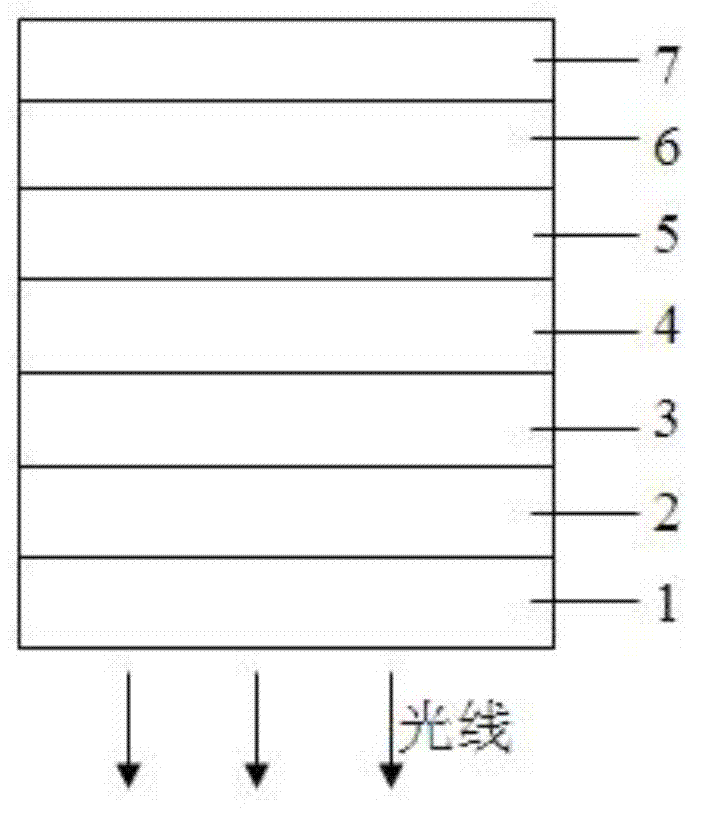Organic electroluminescence device and manufacturing method thereof
An electroluminescence device and a luminescence technology, which are applied in organic semiconductor devices, organic semiconductor device materials, electric solid state devices, etc., can solve problems such as poor compatibility, prone to defects, and hole loss
- Summary
- Abstract
- Description
- Claims
- Application Information
AI Technical Summary
Problems solved by technology
Method used
Image
Examples
Embodiment 1
[0065] An organic electroluminescent device, the preparation method comprising the following steps:
[0066] (1) First set the size to 2×2cm 2 The ITO glass was ultrasonically cleaned with detergent and deionized water for 15 minutes to remove the organic pollutants on the surface. The ITO layer thickness of the ITO glass was 180nm;
[0067] The hole injection layer was prepared by spin coating on ITO glass, and the specific operation was as follows: according to Re 2 o 7 : AIBA: ZnO: polytetrafluoroethylene (PTFE): water with a weight ratio of 30:15:1:2:100, the Re 2 o 7 , AIBA, ZnO, and polytetrafluoroethylene (PTFE) were added into water and mixed evenly to obtain a mixture. The particle size of ZnO was 50nm, and polytetrafluoroethylene (PTFE) was DuPont’s product, model TE3885; The mixture was spin-coated at a high speed, the spin-coating time was 10s, and then dried at 100° C. for 25 minutes to obtain a hole injection layer with a thickness of 80 nm;
[0068] (2) Hol...
Embodiment 2
[0078] An organic electroluminescent device, the preparation method comprising the following steps:
[0079] (1) First set the size to 2×2cm 2 The AZO glass was ultrasonically cleaned with detergent and deionized water for 15 minutes to remove organic pollutants on the surface. The AZO layer thickness of the AZO glass was 80nm;
[0080] The hole injection layer was prepared by spin coating on AZO glass, the specific operation is as follows: according to ReO 2 : AIBI: ZnO: polytetrafluoroethylene (PTFE): ethanol with a weight ratio of 10:2:0.5:0.5:100, the ReO 2 , AIBI, ZnO and polytetrafluoroethylene (PTFE) were added to ethanol and mixed evenly to obtain a mixture. The particle size of ZnO was 20nm, and polytetrafluoroethylene (PTFE) was DuPont’s product, model TE3885; The mixture was spin-coated at a rate of 5 s, and then dried at 200° C. for 10 min to obtain a hole injection layer with a thickness of 100 nm;
[0081] (2) On the hole injection layer, the hole transport la...
Embodiment 3
[0090] An organic electroluminescent device, the preparation method comprising the following steps:
[0091] (1) First set the size to 2×2cm 2 The IZO glass was ultrasonically cleaned with detergent and deionized water for 15 minutes to remove organic pollutants on the surface. The IZO layer thickness of the IZO glass was 100nm;
[0092] The hole injection layer was prepared by spin coating on IZO glass, and the specific operation was as follows: 2 o 3 : V30: ZnO: polytetrafluoroethylene (PTFE): isopropanol with a weight ratio of 60:20:10:5:100, the Re 2 o 3 , V30, ZnO and polytetrafluoroethylene (PTFE) were added to isopropanol and mixed evenly to obtain a mixture. The particle size of ZnO was 200nm, and the polytetrafluoroethylene (PTFE) was DuPont’s product, model TE3885;
[0093] The mixture was spin-coated on the IZO glass at a rate of 6000rpm, the spin-coating time was 30s, and then dried at 50°C for 30min to obtain a hole injection layer with a thickness of 20nm;
...
PUM
 Login to View More
Login to View More Abstract
Description
Claims
Application Information
 Login to View More
Login to View More - R&D
- Intellectual Property
- Life Sciences
- Materials
- Tech Scout
- Unparalleled Data Quality
- Higher Quality Content
- 60% Fewer Hallucinations
Browse by: Latest US Patents, China's latest patents, Technical Efficacy Thesaurus, Application Domain, Technology Topic, Popular Technical Reports.
© 2025 PatSnap. All rights reserved.Legal|Privacy policy|Modern Slavery Act Transparency Statement|Sitemap|About US| Contact US: help@patsnap.com



